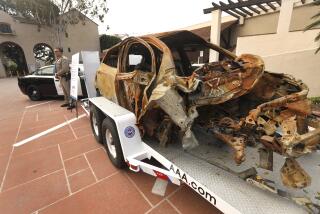THE SAFETY ZONE : Asleep at the Wheel : Drowsy Drivers Are a Major Highway Safety Threat; Gadgets May Help, but Best Remedy Is a Good Night’s Sleep
- Share via
It was 10:30 a.m. and news producer Andy Hoang of Anaheim began dozing off while driving home from work. He thought about stopping to rest but told himself that he could make it the last few miles. Several minutes later he woke up just as his 1994 Honda Civic sped toward the middle divider. He hit the brakes. His car turned around and skidded across the freeway, stopping only after crashing into three trees.
“I thought it was a nightmare,” Hoang said recently about his accident in June, “until I got popped in the face with the air bag. Then I realized it was reality.”
California might be known for road rage and freeway gridlock. But experts say that driving while drowsy poses a major safety risk for motorists, with some officials comparing it to drunk driving.
According to the National Highway Traffic Safety Administration, California ranks second among all states in the annual number of fatal crashes involving a sleepy driver; Texas is first.
Many motorist try to keep themselves awake by opening a window or blasting the radio, but there is no evidence that these methods are effective. Experts say taking a 20-minute nap or drinking two cups of coffee has shown to help with short-term alertness. Other solutions are now being tested in the laboratory.
In July, Anaheim-based Odetics ITS, which designs and manufactures traffic control systems, announced the development of a device that will emit a rumble strip-like sound when drivers begin drifting toward another lane. The unit is mounted to a windshield or dashboard and reads lane markings. Odetics officials say the device is expected to be available in the United States by 2001.
Scientists also have tested the effectiveness of alarms, voice commands, vibrating seats and puffs of peppermint in keeping drivers awake. At the Carnegie Mellon Robotics Institute in Pittsburgh, researchers are developing a system that will sound a wake-up call when a driver’s eyes begin to close for longer than a few blinks.
*
For the time being, experts recommend nature’s own cure to drowsiness: getting a good night of sleep.
Sleepiness can slow reaction time and reduce vigilance, and sleep-related crashes have high mortality rates because they often involve high speeds. Hoang was lucky to survive his crash with only a fractured rib and severe back sprain. He sold his car as scrap for $600.
Federal officials estimate that about 56,000 crashes each year are caused by sleepy drivers, resulting in roughly 1,550 fatalities nationally. Actual numbers are believed to be even higher because no tests measure levels of sleepiness at crash sites.
Although the National Sleep Foundation says most people don’t get the recommended eight hours’ sleep each day, a 1999 report by the NHTSA and the National Center on Sleep Disorders Research has identified groups at high risk for falling asleep at the wheel: people, especially males, between the ages of 16 and 29; night-shift workers or those working long or irregular hours; and people with untreated sleep apnea syndrome and narcolepsy.
The report also listed temporary conditions that may cause sleepiness: driving between midnight and 6 a.m.; driving in the midafternoon (especially for older people); driving long distances without stopping for a break; and driving after taking certain medications, even some antihistamines.
David Willis, president of the Automobile Assn. of America Foundation for Traffic Safety, warns that driving while sleepy is as irresponsible as driving while drunk. He cited a 1997 Australian study that found that a person who has not slept in 24 hours shows the same decrease in driving performance as someone with a 0.10 blood alcohol content. The legal limit in California is 0.08.
“Sleepiness impairs cognition and judgment long before you’re sound asleep,” Willis said, adding that there is still an “everybody does it” attitude toward drowsy drivers. “We’re in the same place with sleepy drivers today as we were with drunk drivers 20 years ago.”
(BEGIN TEXT OF INFOBOX / INFOGRAPHIC)
What to Be Awake For
A typical crash related to sleepiness has the following characteristics:
* Occurs during late night/early morning or late afternoon.
* Is serious.
* Involves a single vehicle leaving the roadway.
* Occurs on a high-speed road.
* The driver is alone in the vehicle.
Signs of drowsiness:
* Eyes closing or not focusing by themselves.
* Difficulty in keeping head up.
* Yawning constantly.
* Not remembering driving the last few minutes.
* Drifting between lanes, tailgating or missing traffic signs.
* Jerking the car back into the lane after drifting.
For more information, National Highway Traffic Safety Administration Auto Safety Line, (800) 424-9393. Web site: https://www.nhtsa.dot.gov






